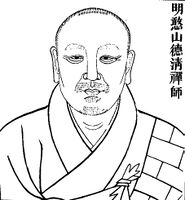Hanshan Deqing
| PersonType | Category:Classical Chinese Authors Category:Ordained (Monks and Nuns) Category:Zen Buddhist Teachers |
|---|---|
| MainNamePhon | Hanshan Deqing |
| bio | Hānshān Déqīng (traditional Chinese: 憨山德清) (1546–1623), formerly transliterated Han-Shan Te-Ch’ing, was a leading Buddhist monk and poet of Ming Dynasty China who widely propagated the teachings of Chán and Pure Land Buddhism.
According to his autobiography, Hanshan Deqing entered a monastic school in Nanjing’s Bao’en temple at the age of twelve. While there he studied literature as well as religious subjects and began writing poetry when he was 17. Two years later he was ordained as a Chan monk under the Buddhist name of Cheng Yin. When the monastery burned down in 1566, he busied himself for some years in keeping the community together and raising money for repairs. Then in 1571 he set out as a religious wanderer, going from monastery to monastery in search of instruction and growing in meditative attainment. After four years he settled on Mount Wutai but by 1583 he had become famous as a Buddhist Master and set out travelling to remote areas again. It was at this time that he prefixed his name with that of Hanshan Peak so as to return to anonymity. In consequence of having organized a successful ceremony to ensure the birth of a male heir to the throne while he was still at Mount Wutai, Hanshan obtained the patronage of the emperor's mother. With her support he was able eventually to establish a new monastery at Mount Lao on the coast of the Shandong Peninsula. But when relations between the Wanli Emperor and his mother broke down over the choice of heir, Hanshan was caught in a conflict which also included tensions between Daoists and Buddhists. In 1595, he was put on trial and imprisoned, then afterwards exiled to the Guangdong area. While there, he made himself socially useful and also helped restore Nanhua Temple at Caoxi which, since the time that Huineng was entombed there, had been converted into a meat market. Some of the monks at the temple made a false accusation of embezzlement of the restoration funds against him and, though he was acquitted, he did not return there. Between 1611-22 Hanshan resumed his wanderings from monastery to monastery and also continued writing the religious expositions and commentaries he had begun during his exile. Shortly before his death in 1623 he returned south to Caoxi, where his body was eventually enshrined. (Source Accessed Apr 19, 2022) |
| YearBirth | 1546 |
| YearDeath | 1623 |
| Other wikis |
If the page does not yet exist on the remote wiki, you can paste the tag |

